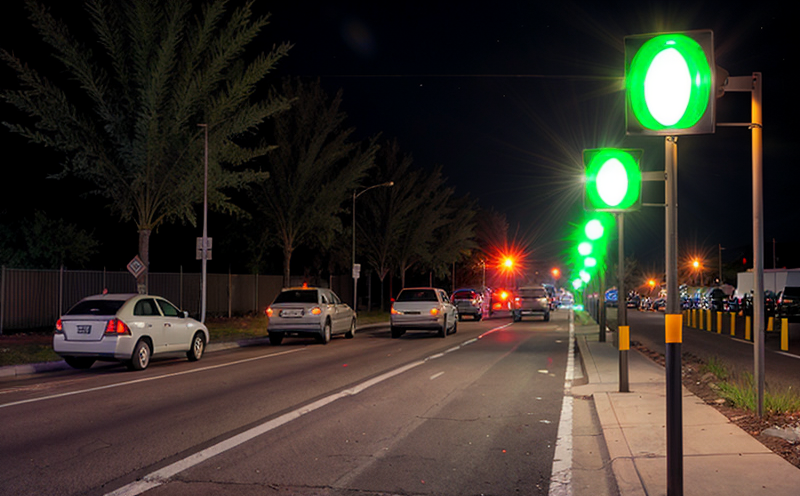CIE 140 Photometric Testing of Pedestrian Traffic Signals
The CIE (International Commission on Illumination) 140 standard provides a comprehensive framework for testing pedestrian traffic signals to ensure they meet the necessary photometric and visual performance criteria. This service is critical for quality managers, compliance officers, R&D engineers, and procurement teams within the lighting sector who are responsible for ensuring that pedestrian traffic signals comply with international standards.
The primary objective of CIE 140 testing is to evaluate the luminous intensity, colorimetry, and visual performance of pedestrian signals. This involves measuring light levels at various angles and positions relative to the signal face. The test setup typically includes a photometer capable of capturing full-spectrum light data, a standard observer, and an integration sphere for accurate measurement.
The testing process begins with careful preparation of the traffic signal specimen. This may involve ensuring that the signal is free from any dirt or debris, adjusting it to its operational state, and calibrating the test equipment. The photometer measures the light output at multiple points across the signal face, recording both luminous intensity and color coordinates.
The results of the CIE 140 testing are used to determine whether the pedestrian traffic signals meet the specified performance criteria outlined in ISO 9605:2013. These criteria include minimum and maximum allowable values for luminance and illuminance, as well as the required color rendering index (CRI) and just-noticeable difference (JND).
Compliance with these standards is essential to ensure that pedestrian traffic signals are visible and legible under a wide range of environmental conditions. Failure to meet these criteria can result in reduced visibility at night, which poses a significant risk to pedestrians and vehicles alike.
The CIE 140 testing process is not only crucial for meeting regulatory requirements but also for ensuring the safety and effectiveness of pedestrian traffic signals. By adhering to this standard, manufacturers and installers can be confident that their products will perform reliably in real-world conditions.
- Benefits:
- Ensures compliance with international standards (ISO 9605:2013).
- Reduces the risk of accidents and injuries due to insufficient visibility.
- Promotes consistency in performance across different lighting conditions.
The CIE 140 testing process is a rigorous yet essential step in ensuring the safety and effectiveness of pedestrian traffic signals. By adhering to this standard, manufacturers and installers can be confident that their products will perform reliably in real-world conditions.
Why It Matters
The importance of CIE 140 photometric testing cannot be overstated. In the context of traffic lighting, visibility is paramount for ensuring pedestrian safety. Poorly designed or improperly maintained traffic signals can lead to accidents and injuries, especially during low-light conditions such as dawn or dusk.
Compliance with international standards like ISO 9605:2013 not only ensures that pedestrian traffic signals meet legal requirements but also demonstrates a commitment to quality and safety. This is particularly important in urban environments where large numbers of pedestrians cross roads regularly.
The testing process itself is designed to simulate real-world conditions as closely as possible. By measuring the luminous intensity, colorimetry, and visual performance of traffic signals under controlled conditions, manufacturers can identify any potential issues before the product reaches the market.
- Benefits:
- Ensures that pedestrian traffic signals are visible and legible in various lighting conditions.
- Promotes consistency in performance across different locations and environmental factors.
- Reduces the likelihood of accidents and injuries due to inadequate visibility.
By adhering to these standards, manufacturers can help ensure that pedestrian traffic signals are safe and effective, contributing to a safer urban environment for all users.
Benefits
International Acceptance and Recognition
The CIE 140 photometric testing process is widely recognized and accepted by regulatory bodies worldwide. The International Organization for Standardization (ISO) has established ISO 9605:2013 as the standard for measuring and evaluating the photometric performance of pedestrian traffic signals. This ensures that manufacturers, installers, and users can rely on consistent and comparable results across different countries and regions.
Many countries have adopted or referenced these standards in their own regulations, making compliance with CIE 140 testing a requirement for importing and exporting traffic lighting products. This global acceptance underscores the importance of meeting these standards to ensure compatibility and interoperability between different systems and environments.
- International Acceptance:
- Compliance with ISO 9605:2013 is recognized by regulatory bodies worldwide.
- Many countries have adopted or referenced these standards in their own regulations.
The widespread recognition of CIE 140 testing highlights its significance in the global lighting industry. By adhering to these standards, manufacturers can ensure that their products are compatible with international systems and meet the expectations of regulatory bodies.





